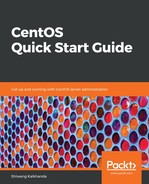The naming of each RPM package file follows a standard, as given here:
name-version-release.architecture.rpm
The naming convention used for RPM packages is shown in the following diagram:

The following table describes the breakdown of various fields used in the naming of RPM packages, and their descriptions:
|
Field |
Description |
|
Name |
It consists of a string describing the contents of the application. |
|
Version |
It is the version number of the application. |
|
Release |
It is the release number of the package set by the packager. |
|
Arch |
It describes the architecture of the package. It says for what architecture the package was built: 32-bit, 64-bit, or both:
|
Using RPM packages for installing an application has the added advantage of manageability (tracking package files, updating the package, removing the package). Almost all software provided by CentOS is in the form of RPM packages.
An RPM package primarily consists of three components: metadata, files, and scripts. Metadata consists of package name, version, release, builder, date, dependencies, and so on. Files consist of archives of files contained in the package to be installed. The scripts file inside an RPM package is executed when the package is installed, removed, or updated.
